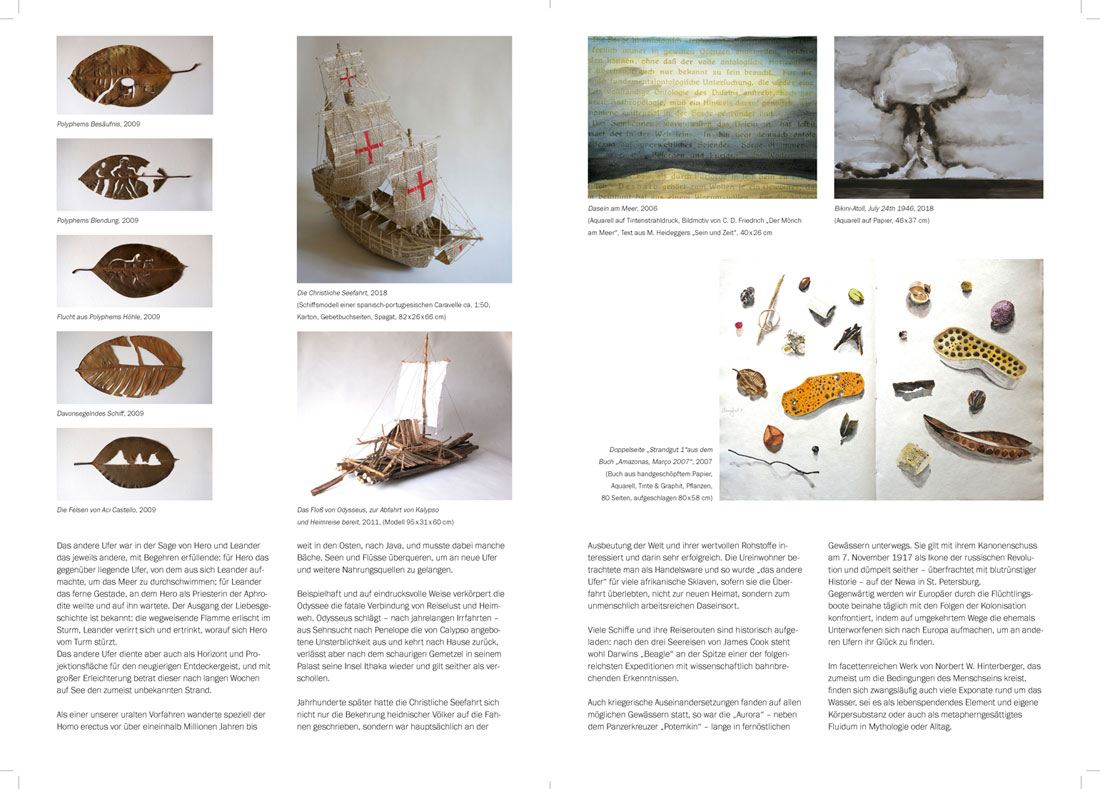Die Kunstsammlung des
Landes Oberösterreich
Studiogalerie im Ursulinenhof
13. Juli 2012 – 15. September 2018
„Das andere Ufer“ war in der Sage von Hero und Leander das jeweils andere, mit Begehren erfüllende, jedoch tragisch endende. Auch die Odyssee mit ihren vielen Landemanövern an fernen Gestaden ist voll von dramatischen Abenteuern und Irrwegen auf der Suche nach der Heimat. Das andere Ufer diente aber auch als
Horizont und Projektionsfläche für den neugierigen Entdeckergeist, und mit großer Erleichterung betrat dieser nach langen Wochen auf See den zumeist unbekannten Strand. Die Christliche Seefahrt hatte sich nicht nur die Bekehrung heidnischer Völker auf die Fahnen geschrieben, sondern war hauptsächlich an der Ausbeutung
wertvoller Rohstoffe interessiert. Auch die Ureinwohner betrachtete man als Handelsware und so wurde „das andere Ufer“ für viele afrikanische Sklaven, sofern sie die Überfahrt überlebten, zum unmenschlich arbeitsreichen Daseinsort. Viele Schiffe und ihre Reiserouten sind historisch aufgeladen: nach den drei Seereisen von James Cook steht wohl Darwins „Beagle“ an der Spitze einer der folgenreichsten Expeditionen mit wissenschaftlich bahnbrechenden Erkenntnissen. Gegenwärtig werden wir Europäer durch die Flüchtlingsboote beinahe täglich mit den Folgen der Kolonisation konfrontiert, indem auf umgekehrtem Wege die ehemals Unterworfenen sich nach Europa aufmachen, um an anderen Ufern ihr Glück zu finden.
The other bank, in the saga of Hero and Leander, was the other one full of desire: for Hero, the opposite bank from which Leander set out to swim the sea; for Leander, the distant shore where Hero was the priestess of Aphrodite waiting for him. The outcome of the love story is known: the groundbreaking flame goes out in the storm, Leander gets lost and drowns, whereupon Hero rushes from the tower.
The other shore also served as a horizon and projection surface for the curious spirit of discovery, and with great relief he entered the mostly unknown beach after long weeks at sea.
As one of our ancient ancestors, Homo erectus migrated far more than one and a half million years ago to the East, to Java, and had to cross some streams, lakes and rivers in order to reach new shores and other food sources.
Exemplarily and in an impressive way, the Odyssey embodies the fatal connection between wanderlust and homesickness. Odysseus proposes - after years of wandering - out of longing for Penelope from the immortality offered by Calypso and returns home, but leaves after the gruesome slaughter in his palace on his island Ithaca and is considered lost since then.
Centuries later, Christian Maritime had not only championed the conversion of pagan peoples, but was primarily interested in and exploited the exploitation of the world and its precious resources. The natives were considered as merchandise and so "the other shore" for many African slaves, if they survived the crossing, not the new home, but the inhumanly busy place of existence.
Many ships and their itineraries are historically charged: after James Cook's three voyages, Darwin's "Beagle" is at the forefront of one of the most momentous expeditions with scientifically groundbreaking findings.
Even warlike conflicts took place in all sorts of waters, so was the "Aurora" - in addition to the battleship "Potemkin" - long in Far Eastern waters on the way. With its cannon shot on November 7, 1917, it is considered to be the icon of the Russian revolution, and since then lumbered - laden with bloodthirsty history - on the Neva in St. Petersburg.
At present, we Europeans are confronted by the refugee boats almost daily with the consequences of colonization, by reversed way the former subjugated to Europe to find their luck on other shores.


